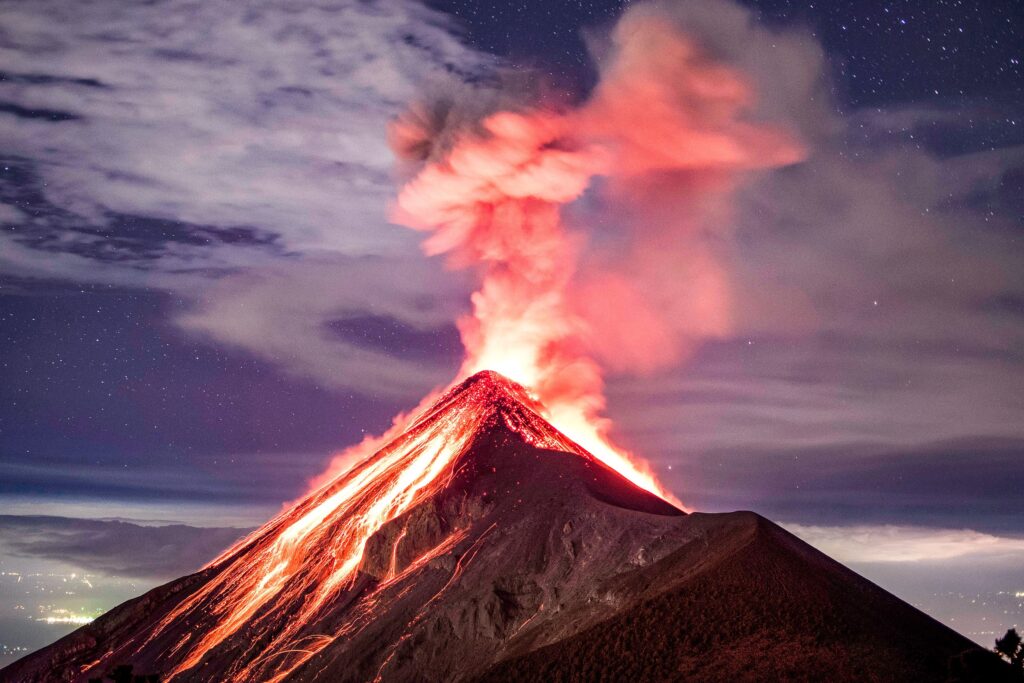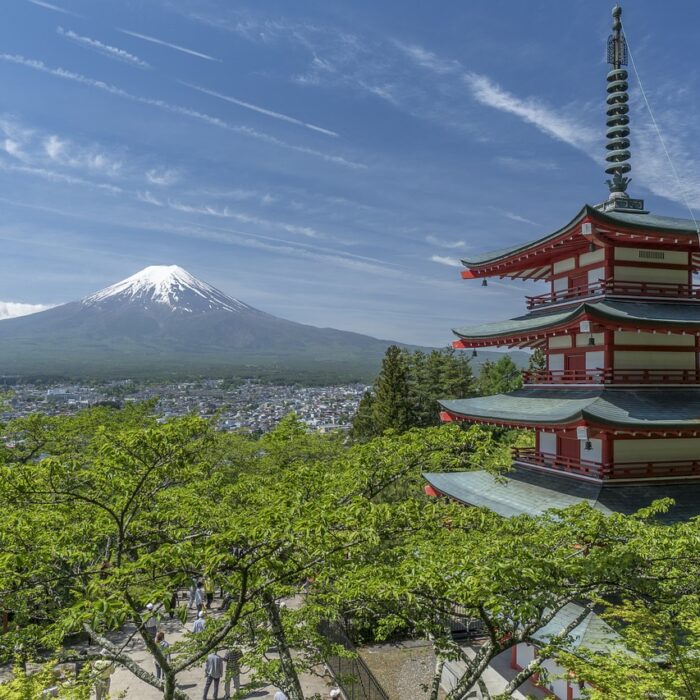Quick facts about Guatemala:
- Population: Approximately 17.3 million people.
- Capital: Guatemala City.
- Official Language: Spanish.
- Currency: Guatemalan quetzal (GTQ).
- Government: Unitary presidential constitutional republic.
- Major Religion: Christianity, predominantly Roman Catholicism with a significant Protestant minority.
- Geography: Located in Central America, bordered by Mexico to the north and west, Belize to the northeast, Honduras to the east, El Salvador to the southeast, and the Pacific Ocean to the southwest.
Fact 1: Guatemala has evidence of a Mayan empire
The Maya civilization, one of the most advanced Mesoamerican cultures, flourished in present-day Guatemala and other parts of Central America from approximately 2000 BCE to the 16th century CE.
Archaeological sites such as Tikal, El Mirador, and Quiriguá are among the most notable Mayan ruins in Guatemala. Tikal, located in the northern Petén region, was one of the largest and most powerful Maya cities, with impressive temples, pyramids, and ceremonial complexes. El Mirador, also situated in the Petén jungle, is known for its monumental architecture and early urban planning. Quiriguá, located in the southeastern part of the country, features intricate stelae and sculptural monuments.

Fact 2: Weaving is still developed in Guatemala and it is part of the culture
Weaving has a long and rich tradition in Guatemala, dating back to pre-Columbian times. It plays a central role in the cultural identity of many indigenous groups, who have preserved and passed down traditional weaving techniques and designs from generation to generation.
In Guatemala, weaving is more than just a craft; it is a form of artistic expression and a way of connecting to ancestral traditions. Many indigenous women are skilled weavers, using techniques such as backstrap weaving, foot loom weaving, and embroidery to create intricate textiles with vibrant colors and intricate patterns.
These textiles hold deep cultural significance and are often used in traditional clothing, ceremonial attire, and household items. Each region of Guatemala has its own distinct weaving style, motifs, and colors, reflecting the diverse cultural heritage of the country’s indigenous communities.
Fact 3: Guatemala has several dozen volcanoes
Guatemala is part of the Pacific Ring of Fire, a region characterized by high volcanic activity due to tectonic plate movements. The country’s volcanic landscape is the result of its location along the boundary of the Caribbean and North American plates, as well as the presence of several tectonic faults.
Guatemala is home to over 30 volcanoes, with some estimates suggesting there may be as many as 37 volcanoes in the country. These volcanoes vary in size, shape, and activity level, ranging from towering stratovolcanoes to smaller cinder cones.
Some of the most notable volcanoes in Guatemala include:
- Volcán de Fuego (Volcano of Fire): One of the country’s most active volcanoes, known for its frequent eruptions and lava flows.
- Volcán Pacaya: A popular tourist destination near Guatemala City, known for its accessibility and ongoing volcanic activity.
- Volcán Tajumulco: The highest peak in Central America, located in the western highlands of Guatemala.
- Volcán Santa María: Known for its dramatic eruption in 1902, which created the Santiaguito lava dome complex.
Note: Planning to visit the country? Check if you need an International Driver’s License in Guatemala to rent and drive a car.

Fact 4: Coffee beans are the mainstay of Guatemala’s exports
Guatemala is renowned for its high-quality coffee beans, which are prized for their rich flavor, aroma, and smoothness. Coffee production has been a cornerstone of Guatemala’s agricultural sector for centuries, dating back to the 19th century when coffee cultivation was introduced to the country.
Today, Guatemala is one of the top coffee-producing countries in the world, consistently ranking among the top 10 coffee exporters globally. The country’s diverse microclimates, fertile volcanic soils, and ideal growing conditions in regions such as Antigua, Huehuetenango, and Atitlán contribute to the exceptional quality of Guatemalan coffee.
Guatemala produces a variety of coffee beans, including Arabica and Robusta, with Arabica beans being the most common and sought after for their superior flavor profiles. The country’s coffee industry encompasses smallholder farmers, cooperatives, and large-scale plantations, each contributing to the cultivation, processing, and export of coffee beans.
Fact 5: The deepest lake in Central America is in Guatemala
Lake Atitlán is a stunning volcanic lake situated in the Guatemalan Highlands, surrounded by towering volcanoes and picturesque Mayan villages. It is renowned for its scenic beauty, crystal-clear waters, and tranquil atmosphere, making it a popular tourist destination and a significant natural landmark in Guatemala.
Lake Atitlán is approximately 340 meters (1,115 feet) deep at its deepest point, making it the deepest lake in Central America. The lake was formed in a volcanic crater and is fed by various rivers and streams that flow into its basin. Its depth and unique geological features contribute to its exceptional beauty and ecological significance.

Fact 6: Guatemala is home to a diverse population with a significant indigenous heritage
Guatemala has a rich cultural tapestry shaped by its indigenous heritage, with over 20 distinct indigenous groups inhabiting various regions of the country. These indigenous communities, including the Maya, Garifuna, Xinca, and others, contribute to Guatemala’s cultural diversity and social fabric.
One of the most prominent indigenous groups in Guatemala is the Maya, who have inhabited the region for thousands of years and continue to maintain their cultural traditions, languages, and customs. The Maya civilization has left a lasting imprint on Guatemala’s cultural landscape, with ancient ruins, ceremonial sites, and architectural marvels scattered throughout the country.
In addition to the Maya, Guatemala is home to other indigenous communities, each with its own language, dialects, and cultural practices. These languages, including K’iche’, Kaqchikel, Mam, Q’eqchi’, and many others, are spoken by millions of Guatemalans and contribute to the country’s linguistic diversity.
Fact 7: Guatemala has 3 UNESCO World Heritage sites
The three UNESCO World Heritage sites in Guatemala are:
- Tikal National Park: Located in the northern region of Guatemala, Tikal is one of the most important archaeological sites of the ancient Maya civilization. It was once a thriving city-state and ceremonial center, with impressive temples, pyramids, palaces, and other structures dating back to the Classic Period of Maya civilization (c. 200-900 AD). Tikal’s monumental architecture and rich cultural significance make it a UNESCO World Heritage site.
- Antigua Guatemala: Founded in the 16th century, Antigua Guatemala is a colonial city nestled in the central highlands of Guatemala. It served as the capital of the Spanish colonial kingdom of Guatemala for over two centuries and is renowned for its well-preserved Spanish Baroque architecture, cobblestone streets, and historic landmarks. Antigua’s cultural heritage and architectural charm earned it UNESCO World Heritage status.
- Archaeological Park and Ruins of Quirigua: Quirigua is an ancient Maya archaeological site located in the eastern lowlands of Guatemala, near the Caribbean coast. It is renowned for its impressive stelae and carved monuments, which are among the tallest and most intricately carved in the Maya world. The ruins of Quirigua provide valuable insights into Maya art, history, and culture, leading to its designation as a UNESCO World Heritage site.

Fact 8: Guatemala’s civil war was the longest in Latin America
Guatemala’s civil war, which lasted from 1960 to 1996, is widely recognized as one of the longest and most brutal conflicts in Latin American history. The conflict primarily pitted the Guatemalan government and military forces against leftist guerrilla groups and indigenous communities, who were marginalized and discriminated against by the state.
The roots of the civil war can be traced back to Guatemala’s history of colonialism, inequality, and authoritarian rule. Tensions between the ruling elite and disenfranchised indigenous populations, exacerbated by land disputes, economic inequality, and social injustice, fueled the armed struggle for political and social change.
Fact 9: U.S. school buses sometimes get a second life in Guatemala
The iconic yellow school buses used in the United States are often retired from service after many years of use or when they no longer meet safety standards. Instead of being scrapped or discarded, some of these buses are sold or donated and find a second life in countries like Guatemala, where they are refurbished and repurposed for use as public transportation vehicles.
Once in Guatemala, these buses undergo extensive modifications and customization to suit local transportation needs. They are typically painted in vibrant colors, adorned with intricate designs, and outfitted with additional seating to accommodate more passengers. The interiors of the buses are often decorated with religious icons, slogans, and other adornments, reflecting the cultural and artistic preferences of their owners.

Fact 10: Guatemala is one of the largest producers of jade
Jade, a precious gemstone valued for its durability and beauty, has been prized by civilizations for thousands of years. Guatemala is renowned for its abundant deposits of jade, particularly in the region of the Motagua River Valley.
The Motagua River Valley, located in eastern Guatemala, is home to some of the world’s most significant jade deposits. The jade found in this region is of exceptional quality, prized for its vibrant green color and translucency. Archaeological evidence suggests that jade was highly esteemed by ancient Maya civilizations, who used it to create intricate carvings, jewelry, and ceremonial objects.

Published April 21, 2024 • 8m to read





